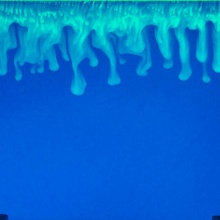Abstract
Karst systems in carbonate rocks are formed in the presence of water that is charged with carbonic acid. It is common knowledge in karst hydrology that the main sources of this CO2 are the activity of microorganisms in the soil and root respiration. The biological activity in soil is subject to seasonal fluctuations (e.g. Dreybrodt, 1998; Ford & Williams, 2007; White, 2018; Klimchouk et al., 2000, and many others). These textbooks and papers also explain that meteoric water is percolating through the unsaturated zone, where it dissolves the CO2. Consequently, corrosion of carbonate rocks starts preferably close to the ground surface, where it causes karst denudation. Karst hydrologists are challenged in explaining why caves with often large cavities form also deep inside the rock. There are currently most notably two accepted explanations. The first one is denoted as ‘mixing corrosion’ and was introduced by Bögli (1980). Mixing corrosion is explained by the always calcite-aggressive behavior of water that is mixed from two water streams, which are each in calco-carbonic equilibrium. This can happen, for example, in joints. The calcite-aggressive mixing water then has new potential to dissolve more carbonates and form cavities. A second explanation assumes non- linear dissolution kinetics, which says that water would keep some of its remaining potential for dissolving carbonates while it is penetrating deep into the rock. This was discussed, e.g., by Gabrovsek & Dreybrodt, 2000; Ford & Ewers, 1978; Dreybrodt, 2004; Kaufmann et al., 2014. A third explanation for CO2 replenishment, in the absence of percolating meteoric water, was recently proposed by us (Class et al., 2021a) and is concerned with density-driven dissolution of CO2 at the epiphreatic karst-water table (Figure 1). We are confident that our preliminary work has demonstrated the plausibility of our hypothesis (see below), but more evidence is still needed in order to substantiate its relevance relative to ‘classical’ theories.
Project leader
apl. Prof. Dr.-Ing. Holger Class
Researcher
Kai Wendel (M.Sc.)
Partner
- Dr. Bettina Strauch, Deutsches GeoForschungsZentrum Helmholtz-Zentrum Potsdam
- Dr. Martin Zimmer, Deutsches GeoForschungsZentrum Helmholtz-Zentrum Potsdam
Duration
1.2023 - 12.2025
Project-related publications
Journal Articles
- Class, H., Keim, L., Schirmer, L., Strauch, B., Wendel, K., & Zimmer, M. (2023). Seasonal Dynamics of Gaseous CO2 Concentrations in a Karst Cave Correspond with Aqueous Concentrations in a Stagnant Water Column. Geosciences, 13, 51. https://doi.org/10.3390/geosciences13020051
- Class, H., Bürkle, P., Sauerborn, T., Trötschler, O., Strauch, B., & Zimmer, M. (2021). On the Role of Density-Driven Dissolution of CO2 in Phreatic Karst Systems. Water Resources Research, 57, Article 12. https://doi.org/10.1029/2021WR030912
Datasets
- Keim, L., Class, H., Schirmer, L., Strauch, B., Wendel, K., & Zimmer, M. (2023). Code for: Seasonal Dynamics of Gaseous CO2 Concentrations in a Karst Cave Correspond With Aqueous Concentrations in a Stagnant Water Column [DaRUS]. https://doi.org/10.18419/darus-3276
- Keim, L., Class, H., Schirmer, L., Wendel, K., Strauch, B., & Zimmer, M. (2023). Data for: Measurement Campaign of Gaseous CO2 Concentrations in a Karst Cave with Aqueous Concentrations in a Stagnant Water Column 2021-2022. [DaRUS]. https://doi.org/10.18419/darus-3271
Contact

Holger Class
apl. Prof. Dr.-Ing.Deputy Head of the Department, Professor for Fluid Mechanics

Kai Wendel
M. Sc.Academic Staff



